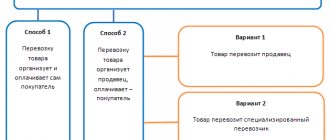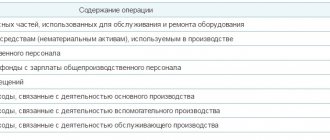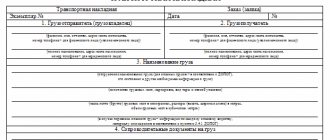What do shipping costs include?
The essence of TR depends on the activities of the organization. For example, a company produces equipment, machinery, raw materials, and various goods. All product units are intended for sale to customers. When concluding a contract with a buyer, it is necessary to transport products from point A to point B. This is usually the responsibility of the seller. The company can also purchase raw materials for the production of its products. Its delivery will also require funds. So, transportation costs include:
- Expenses for the delivery of purchased items (products, raw materials, fixed assets).
- Costs for delivering products to customers.
- Costs for maintaining your own vehicle fleet (this includes costs for car rental, gasoline, repairs and diagnostics of cars).
Question: Can the buyer demand that the supplier compensate for losses in the form of payment for transportation costs for the return of low-quality goods and payment for its storage at a price higher than the market price? View answer
Transport costs can be very high. In this case, they immediately attract the attention of the company’s management and tax authorities. Therefore, an accountant needs to devote time specifically to accounting for expenses related to transportation.
IMPORTANT! Typically, transportation costs are included in the cost of the final product. If the management team decides to reduce the cost of goods, then it makes sense to optimize transportation costs. This process is carried out based on information about expenses that can be obtained from accounting. All data is carefully analyzed, after which a decision is made to exclude certain sources of spending.
For example, an enterprise maintains its own fleet of vehicles, but the cars are used relatively rarely. However, their rare use does not exclude associated expenses. Therefore, the manager decides to disband the fleet. Delivery of products will be carried out under an agreement with a third-party company.
Question: Is a transport invoice required to confirm transport expenses in tax accounting if the buyer has entered into an agreement with a freight forwarder to deliver the goods? View answer
Results
In trade organizations that use SST, the distribution of transportation costs is necessary to determine that part of the costs that can be written off to reduce income tax. Only the costs of transporting the goods to the place of storage (resale) are subject to distribution. The amount of transportation expenses written off to reduce income tax is determined based on the percentage ratio between sold and unsold goods. Other expenses (except for the cost of purchasing goods) are written off in full in the month they are incurred.
You can find more complete information on the topic in ConsultantPlus. Free trial access to the system for 2 days.
Features of accounting for transportation of fixed assets
Expenses for the delivery of fixed assets are taken into account as part of the costs of purchasing and producing products. This rule is fixed in paragraph 8 of the Accounting Rules. It concerns the following fixed assets (FPE):
- created by the enterprise;
- purchased under the relevant agreement;
- purchased under contracts that require payment other than cash;
- objects acquired free of charge (for example, under a gift agreement).
Question: Is it possible to recognize for income tax purposes expenses for transport services of third-party organizations if the taxpayer does not have waybills or are drawn up with violations (clause 1 of Article 252, clause 6 of clause 1 of Article 254 of the Tax Code of the Russian Federation)? View answer
This entire list will be taken into account as capital costs. That is, they increase the initial cost per unit of goods. The expenses in question must be reflected on the debit side of the capital investment account. Correspondence – expense accounts.
However, the listed rules are not relevant for all cases.
The costs of moving objects that do not need installation within the company's territory will be reflected in production costs.
Such objects may include vehicles, individual equipment, and construction sites. Mobile objects may include excavators, concrete mixers, etc. If equipment is moved to a construction site, its movement is associated with installation and dismantling work, expenses are taken into account in the costs of operating the equipment. Expenses will not be included in the original price.
Question: Is a transport invoice (waybill) needed to justify, for income tax purposes, expenses for transport services of third-party organizations (clause 1 of Article 252, clause 6 of clause 1 of Article 254 of the Tax Code of the Russian Federation)? View answer
Postings for transport costs for delivery of goods using examples
Example 1. The amount of transportation costs is included in the price of the goods
The organization VESNA LLC purchased equipment for a total amount of 531,000.00 rubles, incl. VAT - RUB 81,000.00 Transport costs amounted to RUB 29,500.00, VAT RUB 4,500.00. According to the accounting policy of the enterprise, transportation costs are included in the cost of goods. Account 15 is used to form the cost price.
According to paragraph 6 of PBU 5/01, delivery costs may be included in their actual cost. The actual cost is written off to account 41 “Goods”.
The accounting records reflect transportation costs for delivery; we make the following entries:
| Debit Account | Credit Account | Transaction amount, rub. | Description of transaction posting | A document base |
| 15 | 60 | 450 000,00 | The purchase price of purchased equipment is taken into account | Consignment note (TORG-12), Invoice received |
| 19 | 60 | 81 000,00 | VAT on purchased equipment has been taken into account | |
| 15 | 60 | 25 000,00 | Transport costs included | |
| 19 | 60 | 4 500,00 | VAT on transport costs included | |
| 41 | 15 | 475 000,00 | The actual cost of purchased equipment is taken into account |
Example 2. The amount of transportation costs is included in sales expenses
VESNA LLC purchased goods for a total amount of RUB 413,000.00, incl. VAT 63,000.00 rub. Transportation costs amounted to RUB 20,060.00, incl. VAT RUB 3,060.00 According to the accounting policy, transportation costs are included in selling expenses. The cost price is formed on account 41.
According to paragraph 13 of PBU 5/01, transportation costs are included in sales costs.
In accounting, entries for transportation expenses are generated:
| Debit Account | Credit Account | Transaction amount, rub. | Wiring Description | A document base |
| 41 | 60 | 350 000,00 | The purchase price of goods is taken into account | Consignment note (TORG-12), Invoice received |
| 19 | 60 | 63 000,00 | VAT on purchased goods has been taken into account | |
| 44.01 | 60 | 17 000,00 | Transport costs included | |
| 19 | 60 | 3 060,00 | VAT on transport taxes included |
Example 3. Delivery of goods using the services of a transport company
VESNA LLC sells goods to the buyer for a total amount of 885,000.00 rubles, incl. VAT RUB 135,000.00 According to the accounting policy, the cost of transport services is included in the price of the goods. According to the terms of the contract, VESNA LLC must deliver the goods to the buyer. An agreement has been concluded with a transport company for the delivery of goods. According to the terms of the agreement, the cost of services for delivering goods to the buyer is RUB 35,400.00, incl. VAT RUB 5,400.00
The accounting records reflect transportation costs under the service agreement; we make the following entries:
| Debit Account | Credit Account | Transaction amount, rub. | Wiring Description | A document base |
| 62 | 90.01 | 885 000,00 | Accounting for revenue from sales of goods | Consignment note (TORG-12), Invoice issued, Consignment note (form 1-T) |
| 90.03 | 68.02 | 135 000,00 | VAT charged on sales of goods | |
| 90.02 | 41 | 885 000,00 | Write-off of goods sold | |
| 44.01 | 60 | 30 000,00 | Accounting for the costs of delivering goods to the buyer by a transport company | Delivery agreement, Certificate of provision of transport services, Bill of lading, Bill of lading (form 1-T), Bill of lading (TORG-12) |
| 19.04 | 60 | 5 400,00 | Accounting for input VAT claimed by the transport company | Invoice received |
| 51 | 62 | 885 000,00 | Buyer payment for goods sold | Bank statement |
| 60 | 51 | 35 400,00 | Payment to the transport company for delivery of goods | Bank statement |
| 90.07.01 | 44.01 | 30 000,00 | Costs for delivery of sold goods are written off | Accounting information |
| 68 | 19 | 5 400,00 | VAT is accepted for deduction | Book of purchases |
Posting examples
The company sold products worth 900,000 rubles. VAT amounted to 150,000 rubles. The purchase price of the products was 700,000 rubles (VAT – 100,000 rubles). Transportation costs are 20,000 rubles. Let's look at the main wiring:
- Purchase of products by the seller: DT19 KT60, DT68 KT19 100,000 rubles.
- Purchase of products by the buyer: DT62 KT90-1,900,000 rubles, DT90-3 KT68 150,000 rubles.
These postings are relevant when the seller contacts intermediary companies.
Accounting for inventory of goods sold
If the goods and materials are not related to purchased, but already sold goods, then the costs of their delivery can be taken into account in several ways:
- included in the cost of production;
- appear as a separate service provided independently of the implementation.
Most often, enterprises include TZR in the cost of goods. In this case, transportation costs for purchased goods are written off by posting: D90.02 - K44.2. Upon their subsequent sale, TZR (there will be a different amount of expenses) are written off according to the posting: D44.1 - K60, and VAT on them - D19 - K60.
It is noteworthy that tax accounting for transport costs for purchased goods allows you to take them into account in full as expenses when calculating income tax. Difficulties may arise due to determining the time of write-off. After all, direct transportation costs are included in the cost of products and are taken into account only during sales. Indirect ones are in no way related to the time of sales - they are taken into account immediately at the time of their occurrence.
Similar articles
- Accounting for receipt of fixed assets
- Transportation and procurement costs
- Registration price
- Calculation of transport costs - formula
- Accounting for transport costs in the estimate
Calculation of transport costs
The rules for determining transport expenses are contained in Article 320 of the Tax Code of the Russian Federation. The amount of direct expenses related to transportation is calculated based on the average percentage for the current time. In this case, you need to take into account the balance at the beginning of the period. To carry out the necessary calculations you will need:
- Determine the amount of direct expenses for the balance of unsold products at the beginning of the month, as well as sold goods for the current period.
- Determine the cost of purchased products that were sold in the current period. It is also necessary to take into account the value of the balance of unsold objects.
- Calculate the average percentage. It represents the ratio of the amount of direct spending to the cost of production.
- Calculate the amount of expenses that will apply to the balance of unsold goods. It is the product of the average percentage and the value of the balance of objects at the end of the reporting period.
IMPORTANT! Direct expenses, which belong to the balance of unsold products, include all goods to which the enterprise has rights. These include objects that are in the process of being transported to the buyer.
Example of calculations and postings
The company has the following indicators:
- Balance at the beginning of the reporting period for transportation costs: 1000 rubles.
- Costs for transporting products from the supplier: 1,400 rubles.
- Balance at the beginning of the reporting period for goods: 4 thousand rubles.
- Cost of goods supplied: 12 thousand rubles.
- Amount of products sold: 14,000 rubles.
The balance of unsold products at the end of the reporting period will be 2 thousand rubles (4 thousand + 12 thousand – 14 thousand). There is a point in the company’s accounting policy according to which the cost of a unit of goods is formed without taking into account the costs of its acquisition. At the end of the reporting period, the accountant makes the following calculations:
- 1000 + 1,400 = 2,400 (TR balance amount).
- 14,000 + 2,000 = 16 thousand rubles (amount of goods).
- 2,400/16,000 * 100% = 15% (average percentage).
- The TR amount is 300 rubles (2 thousand * 15%).
- The size of the TR with a reduction in the tax base is 2,100 (2,400 – 300).
The postings will be as follows:
- DT 41 CT 60. Amount: 12,000 rubles.
- DT 44 CT 76. Amount: 1,400 rubles.
- DT 90.7 CT 44. Amount: 2,100 rubles.
Concept and types of transport costs
Most companies engaged in manufacturing or trading activities use the services of transport companies or have their own fleet of vehicles. When purchasing assets, the organization also incurs other associated costs, which, together with delivery costs, form transportation and procurement costs (TPC).
Each company is required to enter and approve in its accounting policy a list of expenses that should subsequently be attributed to TZR. Until 2021, for this you need to use legal acts from the following list:
- PBU 5/01 “Accounting for inventories” (approved by order of the Ministry of Finance of the Russian Federation dated 06/09/2001 No. 44n).
Clause 6 of this document shows the costs associated with the procurement and delivery of materials to the place of their use. This:
- costs associated with procurement and delivery;
- costs associated with maintaining enterprise personnel engaged in procurement and storage;
- transportation services for materials and equipment to the place of their use;
- interest accrued on loans from business partners;
- interest accrued as part of loans for the purchase of inventories, provided that these interests were formed before the accounting of inventories.
- Guidelines for accounting for inventories (approved by order of the Ministry of Finance of Russia dated December 28, 2001 No. 119n).
Clause 70 of the guidelines contains a list of material and equipment that can be included in the purchase of materials. This list includes the following types of expenses:
- for loading and transportation, if they are paid outside the basic cost of materials;
- for wages, social contributions and business trips of workers involved in the procurement and storage of materials;
- on the maintenance of actually used warehouse premises;
- payment for services of intermediary companies and individual entrepreneurs;
- to pay for storage services until the moment when the goods and materials arrive at the buyer;
- on interest accrued as part of loans for the purchase of inventories, if these interests were accrued before the moment of accounting for inventories;
- by the amount of losses en route, if their size is within the limits of the standards for natural loss;
- other expenses.
- All-Russian classifier of types of economic activity (approved by order of Rosstandart dated January 31, 2014 No. 14-st).
The classifier has a section “Transportation and storage”, it provides a list of transport services that you should focus on. The fact is that the Tax Code of the Russian Federation does not contain wording on what applies to this type of expense. Therefore, when organizing accounting and tax accounting, it is necessary to create and approve in the accounting policy an identical list of transport services.
It should be taken into account that the type of technical documentation is of great importance for accounting. Namely:
- Inventory related to the acquisition of materials;
- TZR due to the purchase of goods: in a trading company;
- non-trading company;
Let us note the features of accounting for each type.






